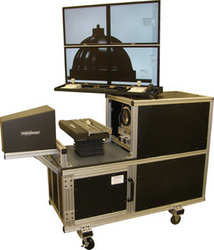Mar 27 2010
VISIONx, manufacturers of machine vision systems and software, has recently developed its VisionGauge® Digital Optical Comparator (Patent Pending) which solves many of the problems and shortcomings of traditional optical comparators, also referred to as profile projectors and contour projectors.
 Digital Optical Comparator standard configuration
Digital Optical Comparator standard configuration
This new system completely revolutionizes optical comparators and takes them into the 21st century.
While optical comparators are generally considered to be a cost-effective measuring tool, it is also widely recognized that they rely on old technology and suffer from a number of shortcomings. Probably the most important of these is the need to use an overlay, also called a template or a Mylar™. With traditional optical comparators, the part's drawing is scaled to match the comparator's optical magnification and printed onto a transparent overlay. This overlay is then placed on top of the comparator's screen and aligned with the image of the part. The operator can then ascertain if the part is within tolerance. There are many problems related to the use of these overlays, including the following:
- The cost of the overlays
- The cost and maintenance of the equipment required to print and calibrate overlays
- The time required to print and calibrate overlays (and verify this calibration)
- Using overlays necessarily introduces an error when printing the part’s drawing onto the overlay (no printer is perfect).
- Overlays can tear, get damaged, stained, worn, etc...
- Overlays need to be physically stored & retrieved. This takes both time and storage space.
- There is a risk that the operator selects the wrong overlay.
- Overlays can only be used by one person at a time.
- If suppliers need to verify parts with an overlay, the overlay must be physically sent to them - resulting in costs and delays.
- Setting up overlays on a comparator is a slow and very operator-intensive process.
- It’s impossible to “recall settings” for an overlay (i.e. position and orientation). The operator must re-align every time he sets up a part.
VISIONx’s VisionGauge® Digital Optical Comparator (Patent Pending) uses a high-resolution digital camera and a very low distortion telecentric lens to capture a high-resolution and geometrically exact image of the part. The VisionGauge® software at the heart of this tool then projects this image, along with the part's CAD overlay, onto a high-resolution quad-monitor display. This approach produces images with an on-screen resolution better than that of traditional 30" optical comparators. The VisionGauge® Digital Optical Comparator also allows for a number of benefits over traditional optical comparators:
- Produces a very high contrast image so there is no problem viewing it in full daylight
- Is much more accurate than traditional optical comparators
- Works directly with the CAD data so that no overlays / templates / Mylars™ are required
- Can be used to collect images (with or without the CAD data overlay and annotations), measurements, and data.
- Can also carry out fully automated measurements (like a video CMM) with sub-pixel accuracy
- Has a smaller footprint and uses less floor space than traditional optical comparators
- Can be moved much more easily and without requiring re-calibration (i.e. “rolling cart” configuration is standard)
- Has a much greater depth of field, (i.e. “everything is in focus all at once”)
- Has a longer working distance: there is thus more clearance between the part and the lens
- Allows you to compare a part to its CAD data beyond the optical field-of-view (because the CAD data tracks the part and follows the stage motion). With traditional optical comparators, the overlay is fixed on the screen and doesn't move when the stage carrying the part moves.
- Has LED illumination for very stable illumination over a 10 year life. This means there are no more bulbs to change.
Because these systems are completely software-driven, it is possible to automate all of the operations, so it is possible to operate the VisionGauge® Digital Optical Comparator using only a barcode reader and a joystick, resulting in very significant productivity gains. Customers typically report doubling their productivity with this equipment, i.e. they can get twice as much work done with a single machine.
This new instrument is the ideal tool when you need to compare a part to its CAD drawing. It is appropriate for a wide range of industries including orthopedics, medical device manufacturing, automotive, aerospace, energy, precision mechanical components and assemblies, etc... It is also appropriate for higher magnification and very high accuracy applications such as Micro Electro-Mechanical Systems (MEMS) device manufacturing, electronics, semiconductor, etc...
The new VisionGauge® Digital Optical Comparator is a very easy-to-use system that is perfectly suited for both the shop floor and the metrology lab. It is available in horizontal and vertical configurations and with industry-standard 5X, 10X, 20X, 50X and 100X magnifications. The VisionGauge® Digital Optical Comparator brings optical comparators into the 21st century using advanced technology to offer a better solution to the classic manufacturing problem of ensuring that parts match up with their CAD drawing.